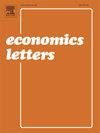COVID-19大流行对危地马拉汇款的影响:因果影响分析
IF 2.1
4区 经济学
Q2 ECONOMICS
引用次数: 0
摘要
汇款是移徙者在外出期间为其家庭的福祉和稳定作出贡献的主要方式。近200万危地马拉裔居住在美国,自2000年以来汇款不断增加。在本文中,我们使用危地马拉银行公布的2002年至2024年的月度数据来研究COVID-19大流行爆发后收到的汇款是否偏离了预期水平。反事实是考虑到过去的趋势和在大流行后时期保持相对稳定的时间序列的变化而产生的。使用贝叶斯结构时间序列模型和推理因果影响,我们发现汇款超过了基于使用外汇储备构建的反事实的预期。自2019冠状病毒病大流行爆发以来,危地马拉收到的汇款增长了23%至42%,与预期水平相比增加了201.7亿美元。我们的分析表明,这种冲击在2024年12月继续产生影响。这可能是由于移民收容国的经济活动较早正常化,采用正式汇款渠道的可能性增加,以及在经济活动正常化后继续提供支持的预期。本文章由计算机程序翻译,如有差异,请以英文原文为准。
The effect of the COVID-19 pandemic on remittances in Guatemala: A causal impact analysis
Remittances constitute a major way in which migrants contribute to their family’s well-being and stability during their absence. Almost 2 million people of Guatemalan-origin reside in the United States, with remittances increasing since 2000. In this paper we use monthly data spanning 2002–2024 published by the Bank of Guatemala to examine whether remittances received deviated from expected levels after the onset of the COVID-19 pandemic. The counterfactual is produced considering past trends and variation with time series that remained relatively stable during the post-pandemic period. Using Bayesian Structural Time-Series modeling and inferential causal impact, we find that remittances exceeded what was expected based on a counterfactual built using foreign currency reserves. Since the onset of the COVID-19 pandemic, remittances to Guatemala increased between 23 % and 42 % resulting in an additional 20.17 billion dollars when compared to expected levels. Our analysis suggests that this shock continued having an effect in December 2024. This is likely due to the earlier normalization of economic activities in migrant-hosting countries, a possible increase in the adoption of formal remittance channels, and expectations of continued support after the normalization of economic activities.
求助全文
通过发布文献求助,成功后即可免费获取论文全文。
去求助
来源期刊

Economics Letters
ECONOMICS-
CiteScore
3.20
自引率
5.00%
发文量
348
审稿时长
30 days
期刊介绍:
Many economists today are concerned by the proliferation of journals and the concomitant labyrinth of research to be conquered in order to reach the specific information they require. To combat this tendency, Economics Letters has been conceived and designed outside the realm of the traditional economics journal. As a Letters Journal, it consists of concise communications (letters) that provide a means of rapid and efficient dissemination of new results, models and methods in all fields of economic research.
 求助内容:
求助内容: 应助结果提醒方式:
应助结果提醒方式:


